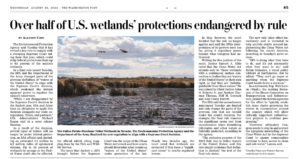Agriculture leaders in the United States House of Representatives are looking to provide at least an additional $10 billion in farmer aid to supplement the recently announced Farmer Bridge Assistance…
EPA Amends “Waters of the U.S.” Rule to Conform With Supreme Court Decision
DTN writer Todd Neeley reported yesterday that, “The EPA removed the term ‘significant nexus’ from the waters of the U.S. (WOTUS) rule in a final revision announced by the agency Tuesday after the Supreme Court in May declared unconstitutional the jurisdictional test that has been the subject of intense opposition and litigation for nearly a decade.
“In addition, the revision clarifies wetlands are not defined as adjacent or jurisdictional in the Clean Water Act solely because they are ‘bordering, contiguous or neighboring‘ or separated from other waters by manmade barriers.
“This was a point of contention in the lawsuit brought by property owners Michael and Chantell Sackett.
The agency’s use of the significant-nexus standard has been at the heart of opposition from agriculture and other industries to recent iterations of the WOTUS rule.
Neeley explained that, “The standard essentially allowed the EPA and the U.S. Army Corps of Engineers to determine whether waters are covered by the law if there is a chemical connection to larger navigable water bodies.”
The DTN article added that, “The EPA and Army Corp of Engineers have scheduled a webinar for Sept. 12, 2023, to provide updates on the new WOTUS definition, according to EPA.
“In addition, the agencies said they are planning a series of listening sessions this fall with ‘co-regulators and stakeholders.'”
And Allyson Chiu reported in today’s Washington Post that, “The Environmental Protection Agency said Tuesday that it has revised a key rule to comply with a sweeping Supreme Court ruling from this year, which could strip federal protections from up to 63 percent of the nation’s wetlands.
“In a final rule issued Tuesday, the EPA and the Department of the Army changed parts of the previous definition of ‘waters of the United States‘ to align with the Supreme Court’s decision, which weakened the federal agencies’ power to regulate the nation’s waterways.

“‘While I am disappointed by the Supreme Court’s decision in the Sackett case, EPA and Army have an obligation to apply this decision alongside our state co-regulators, Tribes, and partners,’ EPA Administrator Michael Regan said in a news release Tuesday.
“As a result of the decision, several types of waters will no longer be under federal protection, an EPA official said, including an estimated 1.2 million to 4.9 million miles of ephemeral streams. Up to 63 percent of wetlands by acreage in the United States could also be affected, the official added, citing mapping done by the Fish and Wildlife Service.”
Today’s article pointed out that, “The issue that Sackett v. EPA brought before the Supreme Court was the scope of the Clean Water Act’s reach and how courts should determine what counts as ‘waters of the United States’ under protection of the law. Nearly two decades ago, the court ruled that wetlands are protected if they have a ‘significant nexus‘ to nearby regulated waters.
“In May, however, the court decided that the rule no longer applies and said the EPA’s interpretation of its powers went too far, giving it regulatory power beyond what Congress had authorized.”
Chiu added that, “The EPA said the amendments announced Tuesday are limited and only change the parts of the previous rule that are invalid under the court’s decision. For example, the final rule removes the significant nexus test from consideration when identifying tributaries and other waters as federally protected, according to the agency.”
In other developments, Reuters writer Rod Nickel reported yesterday that, “Canadian farmers will harvest less wheat than expected after dry conditions in parts of the Prairie provinces shrunk yields, a government report showed on Tuesday.
“Drought is expected to send global wheat stockpiles for major exporters to the lowest levels in more than a decade, a Reuters analysis has shown.
“Canada is the world’s fourth-largest wheat exporter and the biggest shipper of canola, which is used largely to produce vegetable oil.”
The article noted that, “Statistics Canada estimated all-wheat production at 29.5 million metric tons, the second-lowest in eight years, and down 14% from last year. The estimate fell below the average industry expectation of 30.4 million in a Reuters survey.”
Reuters News reported today that, “Chicago wheat prices inched higher on Wednesday, snapping a four-day run of declines, after a survey showed a sharp fall in Canadian production that could curb global supplies.
“Soybean and corn prices stabilised after falling on Tuesday, when U.S. government data showed that hot and dry weather had not damaged U.S. crops as much as thought.”





